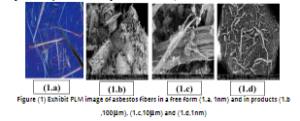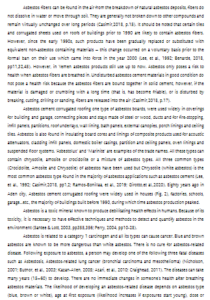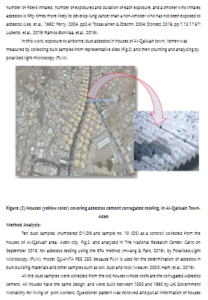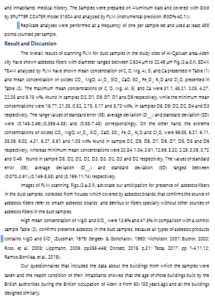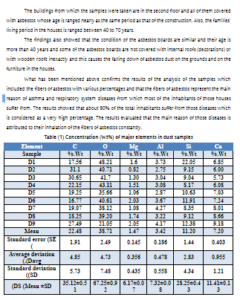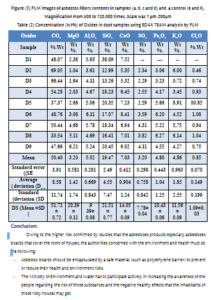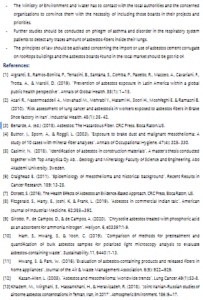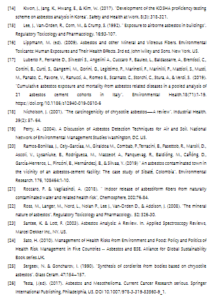Assessment of the Elements and Oxides Concentration in the Dust of Asbestos Used in Roofs of Houses in Al-Qalluah Town, Yemen
Tahir Abdullah Abdulgabbar Salem
Faculty of Saber Education, University of Aden, Yemen
Adel Ahmed Mohammed Saeed
Faculty of Science || University of Aden || Yemen
DOI PDF
Tab title
In this research we evaluated elements and oxides concentration of corrugated asbestos cement used in the roofs of houses in Al-Qalluah area- Aden city, Yemen in the period from August to September 2018. In Aden city, many houses were built between 1880 and 1990 and therefore corrugated asbestos cement roofs as one type of asbestos boards, were used widely in coverage of the buildings and garages. Airborne asbestos fibers may remain suspended in the air for some time and can be carried long distances by wind before settling down. The risk of developing asbestos-related diseases, like lung cancer, is associated with the level and duration of exposure. All the dust samples collected from different sites in Al-Qalluah area were sent to the National Research Center- Cairo and analyzed by QUANTA FEG 250 polarized-light microscopy (PLM), using the EPA 600/R-93/116 method. The overall results of scanning PLM for dust samples have shown fibers of asbestos with diameter ranged between 2.634-22.49μm. PLM quantitative analysis coupled with EDAX TEAM have found the mean concentrations 39, 36.5, 19.2, 31.8, 36.7 and 28.4 wt/wt% with respect to C, O, Mg, Al, Si, and Ca, while the mean concentrations of oxides CO2, MgO, Al2O3, SiO2, CaO, SO3, Fe2O3, K2O and Cl2O, were 46.4, 13.6, 34.8, 47.5, 29.0, 29.1, 31.5, 32.0 and 43.8 wt/wt% respectively. Asbestos boards should be encapsulated by a safe material to prevent or reduce their risks and the authorities should stop asbestos impacts on the environment and human health. Keywords: Elements and oxides analysis, asbestos cement corrugated, polarized-light microscopy, quantitative analysis.
تقدير تركيز العناصر والأكاسيد في غبار أسقف الأسبستوس المستخدمة في منازل بلدة القلوعة، اليمـن
طاهر عبد الله عبد الجبّار سالم
كلّيّة التّربية صبر || جامعة عدن || اليمن
عادل أحمد محمّد سعيد
كلّيّة العلوم || جامعة عدن || اليمن
Tab title
تمّ في هذه الدّراسة تقدير تركيز العناصر والأكاسيد في أسبستوس الإسمنت المتموّج المستخدم كأسقف في منازل بلدة القلوّعة-عدن، اليمن وذلك خلال الفترة من آب وحتّى أيلول 2018م. هناك العديد من المنازل الّتي بنيت في عدن بين عامي 1880-1990م، لذلك يعدّ استخدام إسمنت الأسبستوس المتموّج كأغطية وأسقف هذه المباني والجراجات شائعا. يمكن لدقائق ألياف الأسبستوس أن تبقى معلّقة في الهواء لفترة وتنتقل بالرّياح لمسافات طويلة قبل وقوعها. إنّ مخاطر تطوّر الأمراض المرتبطة بالأسبستوس، مثل سرطان الرّئة، يرتبط بمستوى وفترة التّعرّض له. تمّ جمع عيّنات الغبار من مناطق مختلفة في بلدة القلّوعة وأرسلت للمركز القومي للبحوث-القاهرة لتحليلها باستخدام تقنيّة المجهر الضّوئي المستقطب (كوانتا فيج-250) باتّباع طريقة التّحليل EPA 600/R-93/116. أظهرت النّتائج الكلّيّة لمسح عيّنات الغبار وجود ألياف الاسبستوس بأقطار تتراوح ما بين 6-18 مايكرومتر، بينما التّحليل الكمّي باستخدام مجهر الضّوء المستقطب المرتبط بــ EDAX TEAM أظهرت متوسّطات تراكيز 39، 536.، 19.2، 31.8، 36.7 و28.4 (وزن/وزن%) للعناصر: كربون، أوكسجين، مغنيسيوم، ألمنيوم، سيليكون والكالسيوم على التّرتيب، بينما كانت تراكيز الأكاسيد CO2، MgO، Al2O3، SiO2، CaO، SO3، Fe2O3، K2O و :Cl2O 46.4، 13.6 ، 34.8، 47.5 ، 29.0، 29.1، 31.5، 32.0و 43.8 (وزن/وزن%) على التّوالي. ينبغي تغليف ألواح الأسبستوس المستخدمة في البناء بمادة واقية لمنع أو تقليل مخاطر الأسبستوس وعلى المسؤولين إيقاف تأثير الأسبستوس على البيئة وصحّة الأنسان. الكلمات المفتاحية: تحليل العناصر والأكاسيد، إسمنت الأسبستوس المتموج، المجهر الضّوئي المستقطب، التحليل الكمي
Introduction:
Asbestos is a generic term used for a group of several naturally-occurring minerals found in rock, its mining was completely stopped in 1983 but its usage has not been denied or regulated promptly and universally in all countries. It is still an important social issue in many countries, both industrialized and economically developing ones (Sato, 2010, p.23; Casimir, 2018, p.1; Roccaro & Vagliasindi, 2018).
Asbestos fibers are minerals with exceptional physical and chemical properties: they do not burn; they are remarkably resistant to diverse chemical attacks, depending on the asbestos type, and they show a heightened mechanical tensile strength. They are good thermal and electrical insulators. These properties have led to the development of the use of asbestos fibers in multiple forms for manufacturing numerous widely-consumed industrial products and in the construction of buildings (Lee, et al., 1992).
While asbestos is not volatile, small fibers and clumps of asbestos fibers may be released to ambient air as a dust (Lee, et al., 1992; Khadem, et al., 2018), and the health risks of exposure to such fibers/dust have been studied and debated for many years (Hwang & Park, 2016; Kwon, et al., 2017; Algranti, et al.,2019; Fitzgerald, et al.,2019). Clumps of mined asbestos can be broken down into loose fibers or fiber bundles, and can be mixed with other materials, such as cement, to produce a variety of building products (Figs. 1.b-1.c and Fig. 3.f gaskets disk). Asbestos fibers are not visible to the naked eye but, they are very light, remain airborne for a long time, and can be carried by wind and air currents over large distances by wind before settling down (Casimir,2018, p.15).
